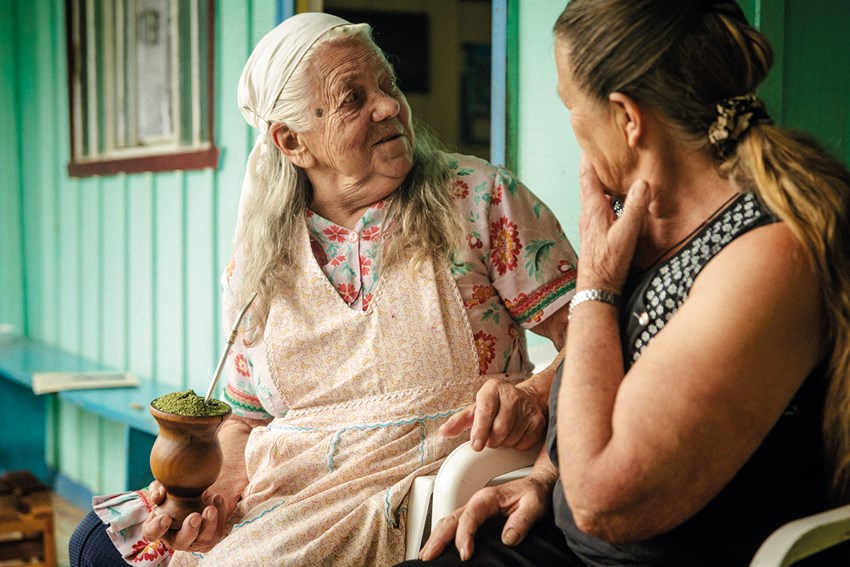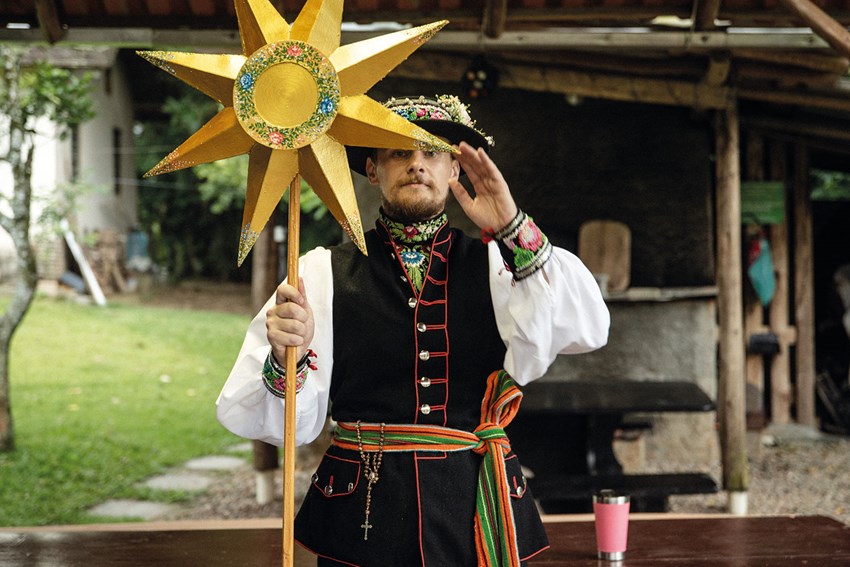Thursday, April 10, 2025
Welcome to Brazylia: how Polish music took root in southern Brazil
Magda Tejchma reports from Brazil where she finds Polish immigrants and their descendants playing the polkas, waltzes and obereks of their ancestors, deep in the Brazilian hinterlands. Photos by Piotr Baczewski

Michał and Polan Szymanek recording in Polan’s house
Linha Guarapuava is a winding, difficult-to-access road, covered in the ubiquitous red mud found across Paraná. Dotted off the road are rare settlements surrounded by Araucaria forest, which is where you will find the colourful wooden house of Polan Szymanek. Polan and his older brother Michał describe the landscape in songs that are unique hybrids of Brazilian gaúcho music with lyrics in archaic Polish. They sing about the hardships the first arrivals from Poland to Brazil endured: ‘They only met forests here, there were various animals, there were great vipers.’ In that same song by Michał Szymanek, they sing that their ‘grandfathers and great-grandfathers sailed with a great company and carried the image of Our Lady of Częstochowa in a ship’. In southern Brazil, Polish is still sung, spoken and played, and there are even traditional tunes that may have been performed in the Polish countryside more than 100 years ago.
Poles arrived in Brazil along with a great wave of other economic migrants from Europe in the late 19th century. It’s estimated that between 1890 and 1914, more than 100,000 people of Polish origin left for Brazil. They were sent to the south of the country – the states of Paraná, Santa Catarina and Rio Grande do Sul, where they were given large tracts of desolate land that they could have only dreamed of in densely populated Poland. In such isolation, it was natural that they cultivated the traditions they knew and brought with them. Immigrants organised themselves locally, built schools and churches, founded agricultural associations, and adapted to Brazilian conditions, while still living in ‘the Polish way’. It’s estimated that there may be more than two million people of Polish origin in Brazil today. Polish culture can be seen mainly in the colonies, villages and small towns; in some of those, Polish is even a second official language, as in Mallet in Paraná and Áurea in Rio Grande do Sul.
I’ve visited the Brazilian Poles twice with Muzyka Zakorzeniona, a Polish NGO that disseminates and documents the traditional music of the Polish countryside. We aim to record as many tunes, songs and stories as possible, and create films and radio programmes. Until recently, the only release that featured Polish music in Brazil was Poles in Brazil and Argentina, released in 1998 by Polish Radio (on a trip this year, I actually met a Pole who was travelling around the south of Brazil to retrace the footsteps of that album!). One of the people who helped us organise our trips was Lucas Antunes dos Santos, director of the Mazury folk group from Mallet. Although his band is a typical song and dance ensemble, Lucas understands the importance of the region’s intangible heritage and is creating a database of Polish colonisation with names and digitised documents. He also organises a Polish folk music festival in Mallet, featuring local musicians and Polish groups from other towns – in 2024, it was held for the fourth time. It’s a small December event, so people sing carols, Polish choirs appear and accordionists play wedding marches. Lucas stresses that “the band’s motto is ‘more than just folklore’; it’s about building bonds and a place to come together”.

Julia Dziurza and Leonarda Nasiłowska
Polan (b1961) and Michał (b1959) Szymanek, fourth-generation immigrants, both play guitar and accordion, and also compose lyrics. They speak Polish fluently: “We started learning Portuguese in primary school; only Polish was used at home!”, says Polan. Yet it was only spoken – Polan, Michał and their families cannot read Polish. They have dozens of songs in their repertoire: “We started creating them because we lacked cheerful songs in Polish”, adds Polan. They compose music based on popular gaúcho melodies. Like many gaúcho songs, their lyrics are about everyday life, work and the rural ethos. However, with their own unique twist: the brothers sing about Pope John Paul II, who is adored by Brazilian Poles; they tell the story of Polish emigration in Cruz Machado municipality – where Linha Guarapuava is found – recalling a tragic episode of a typhoid epidemic; about Polish holidays, customs and superstitions; and about their family history: ‘our grandmother and her father had a little house made of ferns, she was 13 years old and had to dig roads’ (lyrics from ‘Jestem Wnukiem Emigrantów’).
At first, the Szymaneks’ music did not get the community’s approval; for the locals, ‘real’ Polish folk music should be beautiful, colourful and in folk costumes. However, the brothers gained notoriety over time, with help from the local radio, which started to broadcast their songs on the Polish language programme Hora Polonesa. When I first arrived at Polan’s house, we began by recording wedding songs performed by his mother-in-law, 85-year-old Julia Dziurza, and her neighbour Leonarda Nasiłowska – both of whom had sung at Polish weddings in their youth. Julia spoke hardly any Portuguese; she didn’t need it for anything, having spent practically her entire life in one house, in the middle of the forest, with her family.

Jailsson Fabijaki during carolling in Indaial
The situation of Polishness in Santa Catarina – the state directly south of Paraná – is somewhat different. This area is mainly inhabited by descendants of Germans, which is particularly evident in the architecture of Pomerode or in Blumenau, where a gigantic Oktoberfest is held annually. Jailsson Fabijaki, a young history teacher and dancer, lives in Indaial, in the picturesque, hilly region of Blumenau. The Polish language is already disappearing there. Jailsson himself speaks Polish quite poorly, struggling to find words: “I learned to dance in a now-defunct regional troupe and from… the internet, I followed traditional dance lessons on one of Poland’s educational portals”. In 2022, Jailsson founded the Chłopi (Peasants) dance ensemble, which cultivates the customs, dances and rituals of the Łowicz area in central Poland and is a tribute to the writer Władysław Reymont, author of the 1904 novel Chłopi. He also watched the famous 1972 TV series adaptation of Chłopi, which used authentic melodies by the virtuoso Stanislaw Klejnas, a fiddler from Raducz in central Poland. For Jailsson, it was a shock: “His playing makes your legs move on their own and your heart beat with the same frequency. This music is a reflection of the Polish spirit!” His troupe dance to the raw, rootsy recordings of Klejnas, a situation I’ve never seen in Poland.
Against the backdrop of the outdated model of stylised song and dance ensembles adored by the Brazilian Polish community, Jailsson’s thinking is subversive: “We have many dancers here in Brazil who consider real traditional dances unworthy of attention and folk ballet as something almost divine. Polish folklore ensembles in Brazil are destroying their own cultural background by trying to imitate famous state ensembles that are brought here from Poland.” In February this year, Jailsson started a project in Blumenau to teach traditional Polish dances in a roots form. He dreams of organising a dance party like in Central European dance houses. For the time being, the dances are taught by dancers from German ensembles; there is little interest in the subject among descendants of Poles.
When going to Brazil, we had little idea of the forms of Polish folk music that would await us. We heard popular songs still played at Polish weddings, some of which made their way to Brazil through the media, as well as Christmas carols and religious songs handed down by Catholic priests from Poland. But what we didn’t expect, in the middle of a dense southern Brazilian forest near Mallet in Paraná, was to encounter a band playing obereks, polkas, kujawiaks and marches on violin, basy (cello-like bass) and frame drum. This set-up was popular in central Poland pre-WWII, before the popularisation of the three-row button accordion. It was the basy that gave this music its archaic flavour, played rhythmically, steadily, without shortening the strings. Nowadays, the basy has almost completely disappeared in central Poland, making it all the more exciting to see and hear it in Paraná!
The Mallet area is home to several colonies of Poles and Ukrainians that settled there in the late 19th century, many of whom still live in the same houses as their ancestors. Such is the case of the small farm belonging to violinist João Błaszczyk (1929–2025), the former leader of a band renowned by Poles in Mallet for its musicianship. Members of the Błaszczyk family still form the backbone of the band today. João and his brother Feliciano (b1937) would have both played violins, Feliciano saying that they played on “thin and thick strings” – one playing high strings and the other low – and he adds that “basy was played by our late brother Paulo, the frame drum was played by whoever”. The band would play Polish weddings and parties in Mallet; Feliciano recalled that “the old people only wanted to dance to violin, basy and drum – such old-timey Polish music; the place would start jumping!” Today, Feliciano is the guardian of Polish repertoire around Mallet; he took over the melodies and the job of leading wedding orations from his brother and from the colony’s violin master, Bronislaw Karolkiewicz. Indeed, the elderly Feliciano plays in a manner hardly different from traditional Polish realities – on double strings, with the melody preceded by a przyśpiewka [solo couplet] from the violin. The Błaszczyk family don’t know where their ancestors came from in Poland, but the repertoire reminds me of old recordings from around Sieradz in central Poland: obereks, polkas, swinging kujawiaks. Part of the repertoire is made up of marches: “You had to play a march to everyone invited to the wedding; otherwise, shame on you!” remarks Feliciano.
Before Paraná’s typical rain began, we managed to record a band – with Feliciano on violin, his son Janek on drum, nephew Józef on basy and Augusto, a neighbour and local luthier, on second fiddle. The biggest musical surprise, however, came days later. At the Mallet festival, Feliciano played a folk waltz, which we recognised as a version of the Polish anthem, something which Feliciano didn’t realise: “It’s such a polka, but I play it as a waltz!” he adds.
The music of the Poles in Brazil comes out in full force at weddings. The opportunity for us to hear it in this setting came unexpectedly. Tired after a day of recording, we returned to our hotel, where a wedding between a Polish and Ukrainian couple was beginning. Dancers held piniorki – wedding bread decorated with ribbons and sprigs of Araucaria – above their heads, before passing it on to another person in the procession. It’s a version of the ceremonial dance of bridesmaids in some regions of Poland and Ukraine. One of the people from Mallet told me, “Here it was only danced by Ukrainians, but Poles liked it and do it too”.
The next day, I talked about the party with members of Vento Sul, a wedding band from Mallet whose members are all of Polish descent. They play with a contemporary line-up of guitar, bass, drums and two accordions, with violin adding a traditional element. “We play so that everyone can dance and we have an occasion to play, that’s our community: Poles, Ukrainians and Brazilians”, says the group’s Augusto Gabrielczuk. Just a few decades ago, Polish-Ukrainian marriages were rare in the provinces, the two nations treating each other with a hint of rivalry. Poles marrying Brazilians were also unwelcome, with one elderly singer stating bluntly, “You can’t speak Polish around here anymore. Everyone has sold out for Brazil!”
Other members of Vento Sul include 15-year-old violinist and guitarist Kauã Vitorio Komar Michalczuk and his friend, 17-year-old accordionist Alisson Kurzydłowski. Kauã and Alisson are the youngest people I met in Brazil keen to play and seek out Polish music, but they are most likely to play tunes brought directly from Poland. We explain to them that the source beats next door – Feliciano Błaszczyk will drop everything and become 20 years younger when he plays the violin with someone. Poles in Brazil still underestimate the importance of their disappearing culture, but it is not too late to save it.

